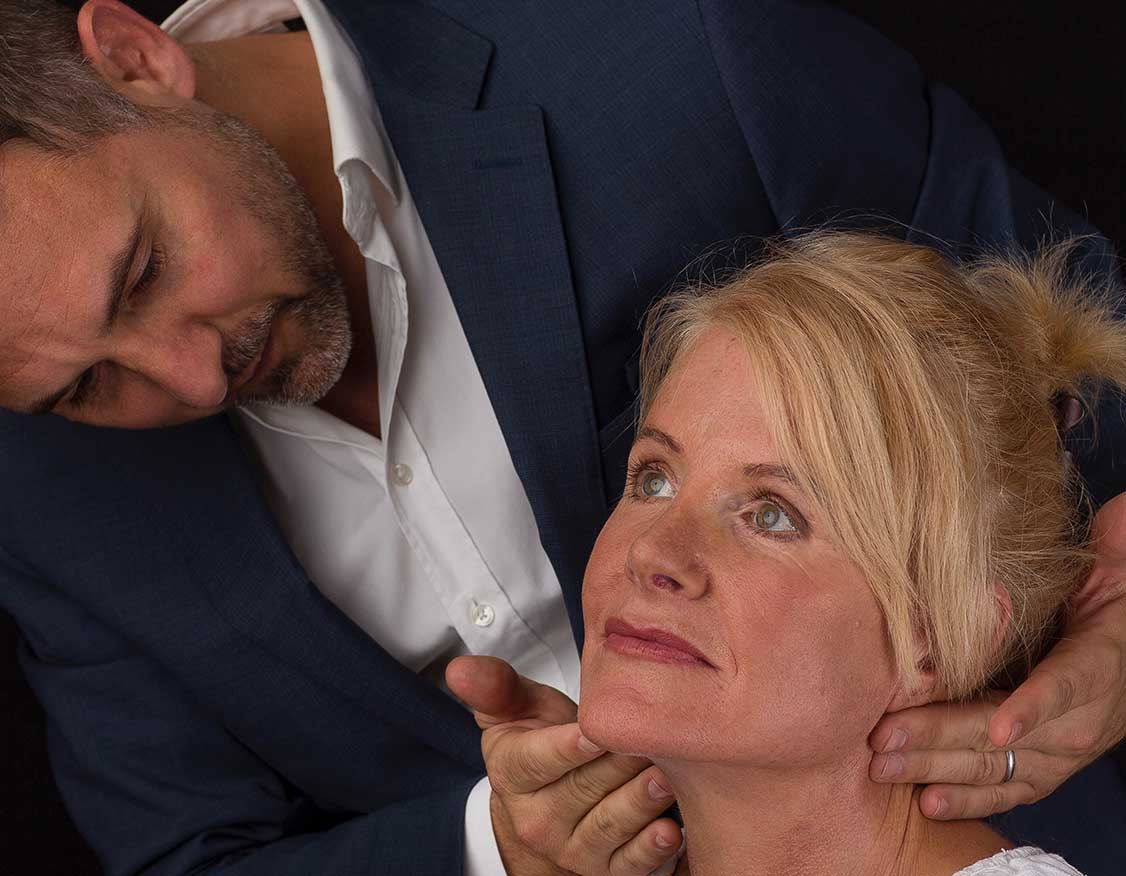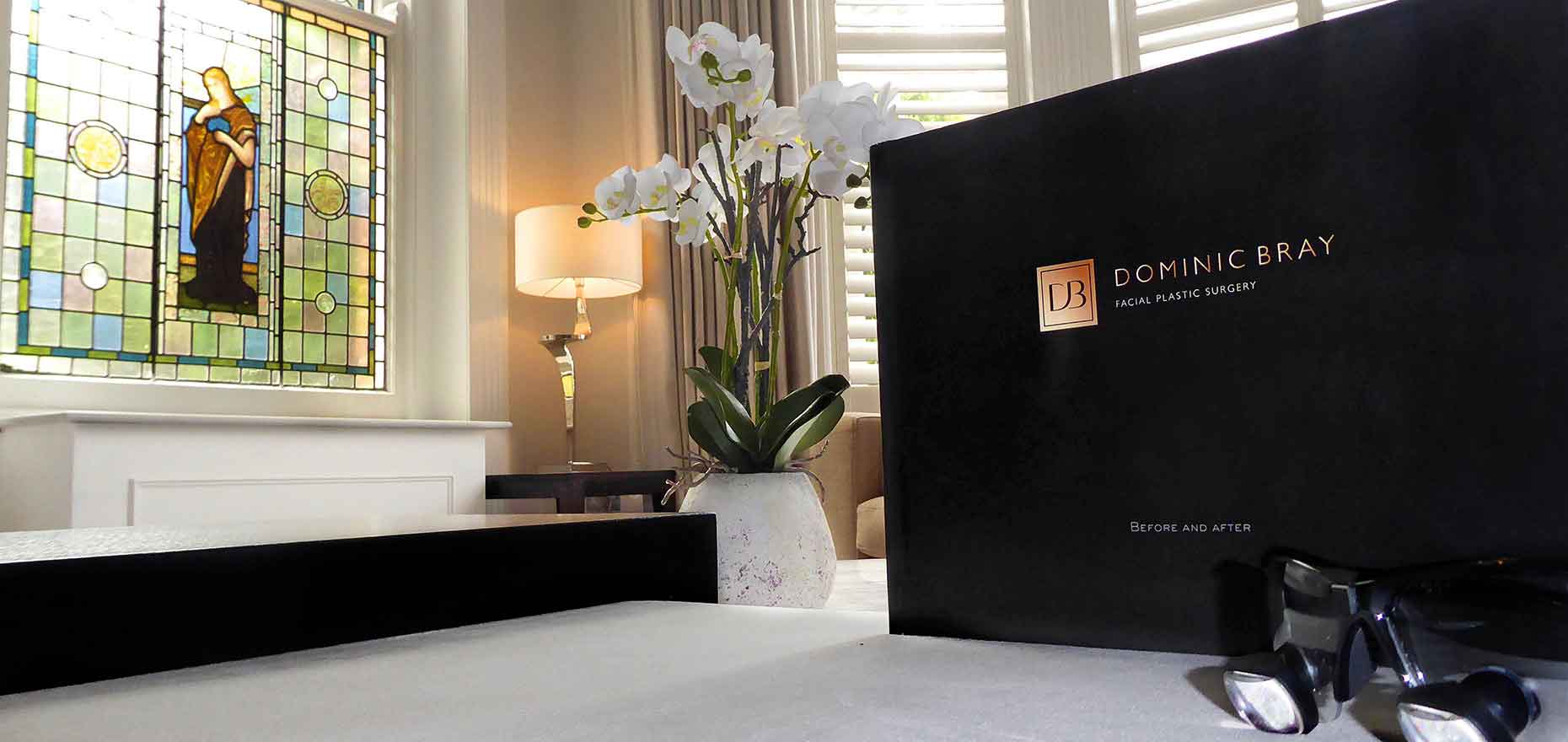Frequently Asked
Questions
Some of the most common questions about facial plastic surgery procedures are answered here. Our team will be happy to answer any others.

How long is the recovery from a facelift?
Facelift surgery takes months to fully heal and settle but in general most patients feel comfortable to return to professional and social activity after 2 weeks with carefully worn makeup and hairstyling. Return to physical activity and sports from 4 weeks. See Val’s recovery here.
How long before my scars disappear?
Once the stitches come at at 7 days, the incisions are still healing and are obvious with your hair up. Scars then become redder as blood flows into the new scar to help nourish the healing wound. After 3-6 weeks the redness fades and the scar contracts to fade away completely in almost all patients. Usually by 3 months scars are barely perceptible. See Helen’s healing here.
How long does a facelift last?
This is a tough question to answer, as how does one define last. A facelift puts the facial clock back but the clock keeps ticking. Most patients after deep plane facelift surgery are still enjoying the benefits 10-15 years after their surgery but of course will have aged from a younger looking position in that time.
Don't facelifts look obvious?
If planned and performed by an expert facelift surgeon with meticulous planning, bespoke tailoring and a precision approach in the deep plane, a facelift is a whisper not a scream, you’ll look like a better more beautiful version of you. If not, the quick answer is yes, short cuts and tension leave scars and a trademarked, cookie cutter, one-size-fits-all approach can lead to obvious deformity of tension and vector. See here.
Do I need a platysmaplasty?
In patients whose deeper neck structures are contributory to their loss of neck chin angle, the deep neck, muscles, fat and glands (deep to the platysma muscle) needs to be sculpted to achieve a beautiful neckline. Liposuction alone removes superficial fat which isn’t the cause and can lead to more obvious neck banding. In patients with strong neck bands or significant skin redundancy a platysmaplasty addresses these and remodels the neck chin angle.
Is platysmaplasty painful?
The soft tissue and muscle work isn’t painful at all. Where the new neck chin angle is temporarily stitched to the underlying cartilage, it can catch on swallowing and feel like a tight band under the chin. This subsides after a few days and resolves within the first 4 weeks. A platysmaplasty does not affect breathing or swallowing.
I have lumps and bumps in my neck following surgery is this normal?
Completely. All patients have lumps and bumps and can feel ridges where the underlying work has been performed. These soften out and disappear as healing progresses, they are usually invisible to others after 10 days and are generally no longer felt by 4 weeks.
I've had a facelift when can I wash my hair?
We wash your hair for you the day after surgery. It can be washed again at home if you are desperate but it is best left for a few days so as not to get the hairline incisions wet. Think what happens to a healing graze in the bath! A gentle hairwash the night before stitch removal at one week is fine if you are gentle near the incisions.
I just want a face lift or a neck lift why do I need both?
This is a common question and many surgeons offer either/or. This shows an inexpert understanding of the anatomy of facial descent and usually caters to what patient’s ask for not what they need. The face and neck should be thought of as one unit (because they are) and should be rejuvenated together for a natural balanced rejuvenation. A tight neck with jowls is as unattractive as a tight jawline and sagging neck. See May’s case as an example.
I have uncontrolled high blood pressure is that a problem?
Potentially yes. The main cause of bleeding after a facelift is high blood pressure. Patients with uncontrolled (and whitecoat) hypertension are at greater risk of bleeding and haematoma. It is best to have your blood pressure under control with tablets before considering elective aesthetic surgery.
My husband / partner doesn't want me to have surgery?
Then you have a partner who loves you just the way you are, that’s what we all want! Husbands are worried their wives will look operated on (the media is full of bad facelifts) and don’t appreciate the reward for the risk. This is because men (luckily) do not lose their main sex hormone, experience a menopause or as significant facial ageing as women. At three month review our team has heard from an accompanying husband “I get it now, I’ve got my girl back” more times than there are pages on this website!
Bring your partner to consultation, We will help him understand! Also see our philosophy.
Is facelifting painful surgery?
Facelifts can be uncomfortable in the first few days if the deeper ligaments haven’t been released (SMAS lifts). Deep plane facelift is a tension free procedure so pain is minimal to non existent. As the face swells in the first 48 hours, the face can feel tight and uncomfortable but not painful and is easily managed with paracetamol alone.
How long does it take for swelling to go?
Swelling is usually at its maximum 2-3 days after surgery. Sleeping upright, using icepacks and avoiding salty foods will help it reduce faster. After one week most patients feel really swollen, this reduces by 50% at 2 weeks and 75% at 4 weeks when it actually flatters a result. Swelling is generally gone by 3 months in most patients.
Am I too young / too old for a facelift?
I do not operate on a date of birth! If a patient’s face has aged prematurely in their mid thirties I would rather offer them a definitive fix rather than encourage them to spend their money on equivocal non-surgical skin tightening or disappointing thread lifts. Likewise I have performed facelifts on patients in their 80’s. They want to look as young as they feel!
What is a platysmaplasty?
The platysma muscle is a thin scarf like muscle just under the skin of the neck and the lower face. As we age, the scarf can split under the chin to create 2 (or more) bands. The front edge of these bands are the two front edges of the platysma muscle. A platysmaplasty via a small under chin incision reduces, reorientates and reattaches the muscle to recreate a youthful neck chin angle, and allows access to the deeper neck structures.
How many patients need a platysmaplasty?
In my exclusive face and neck lift practice, 80% of my patients need a platysmaplasty for the best and lasting outcome.
Can Deep plane face and neck lift be performed under local anaesthetic alone?
Yes the surgery can be performed painlessly under local anaesthetic alone. However, as this is comprehensive deep plane surgery it is never rushed and can take up to 4 hours. That is a long time to lie in one position so I prefer to make the time pass comfortably for my patients with a little sedation.
I am a week out, why do I look worse than the patients in your gallery?
You are not alone! All my patients feel they look worse than they actually look and are surprised they don’t look as swollen as they feel when we take one week photos. Patience and allowing your body to time to heal is key, let my team and I take the worry off you, another week of recovery makes a huge difference.
When can I apply make up?
As soon as you want. Just avoid covering incisions where the skin is healing to prevent infection.
I smoke, will you perform a facelift on me?
I am first and foremost a doctor and will always have your best health interests at heart. Smokers have a higher risk of poor wound healing, scarring, infection and necrosis of skin, so I insist my patients having face and neck lifts are not actively smoking or using nicotine replacement in the 4 weeks before and 4 weeks after surgery.
I am planning to lose weight, should I have a facelift first?
When a face and neck lift is performed, your new facial contour is perfectly tailored to your face as a shirt would be to a body. Dramatic weight loss, or worse yoyo weight loss and gain, means the shirt doesn’t fit as well. It is best to achieve your ideal and sustainable target weight and then have a facelift.
Why do patients seek revision facelifts?
Facelift surgery is surgery of confidence and peace of mind. Having plucked up the courage to undergo surgery, sometimes patients feel there is little improvement in confidence or appearance or worse have the dreaded tell tale signs of surgery. I explore this further here.
What factors need to be considered?
The main challenges that arise in revision relate to what was done in the primary surgery. If too much skin was removed in the wrong vector, getting a new tension free closure to the skin (whilst removing the old scarring) might need significant deeper remodelling of the facial soft tissues. The type of facelift surgery previously performed, health of the skin and health of the patient are all important.
Are the risks higher with revision facelift surgery?
If performed at the appropriate time after primary surgery, with all knowledge to hand and a clear plan, the risks remain the same, although the surgery is technically more challenging.
How experienced are you at revision facelifts?
I perform about 130 comprehensive deep plane face and neck lifts a year, 50 or so of which are revision or secondary facelift surgery which places me comfortably in the top 5% of surgeons globally performing facelift surgery by numbers. At this stage in my surgical evolution I genuinely enjoy the challenge of revision facelift surgery.
What are the common factors you see in facelifts that need revision?
I cover this in depth in the section on Revision facelift surgery. There is most definitely a pattern in patients seeking revision facelifts. Proper detailed research is important to prevent an unsatisfactory outcome. In this area unfortunately you pay for what you receive.
When is the best time to revise a facelift?
Facial tissues need time to settle after surgery, scars need to mature and blood supply to skin needs to have re-perfused. This process can take up to a year following primary surgery.
Is revision facelift surgery more difficult?
Yes. Without a doubt. Skin removal, internal scarring, disruption of tissue planes and dented trust in facelift surgery all conspire to make revision surgery more challenging. On the positive side, it is hugely satisfying to repair all of these for a facelift expert.
I have awful scars from a previous facelift what can be done?
This depends entirely on the cause of the visible scarring. Scars that are thickened and red with earlobe lengthening are deformities of tension on the skin as can be seen here. Excising the scar and restitching is unlikely to correct the tension deformity caused so deeper plane work should be performed. Steroid injections, 5FU and lasers can be helpful to achieve improvements in some.
What makes a surgeon a facelift expert?
There are three main factors, Experience, focus and artistry. With experience comes technical surgical evolution, humility and learning from long term outcomes. Limiting a practice to facial rejuvenation surgery alone ensures focussed expertise and like all things in life some people are more artistic than others, or rather, what one person considers an attractive result might be average to someone with a greater innate sense of beauty. Whilst certificates, affiliations and published papers are important, this is where longer term before and after outcomes are key.
What is a mini facelift?
This is a tough question as there is no accepted or standardised definition. A mini facelift is a normally a smaller version of a SMAS plication or SMAS imbrication technique and targets early jowls. In my practice, for the few patients that are suitable I use a SMAS imbrication or MACS type technique. Learn more here.
How long does a minifacelift last?
I always tell my patients that the ‘mini’ in mini facelift refers to incisions, dissection, recovery, effect and longevity. It isn’t a short cut to the results achieved with deep plane face and neck lift surgery, but the results, cost and longevity compare very favourably with the plethora of nonsurgical skin tightening devices out there. I have seen mini facelift patients still enjoying the benefits 3-5 years after surgery so it should be considered a temporising procedure before considering more definitive face and neck lifting.
How is a minifacelift performed?
Entirely under local anaesthetic as a day case procedure, after the incision the skin is lifted off the underlying SMAS fascia. Stitches are then used to tighten the SMAS which creates lift and skin redundancy. Excess skin is removed and tailored meticulously before being closed with fine stitches.
Who is suitable for a minifacelift?
Patients with mild jowling, good skin elasticity and very little laxity within the neck are the best candidates. Usually this is patients some way off the menopause who don’t yet have significant laxity in the SMAS to benefit from more comprehensive deep plane facelift.
Where is the incision for a minifacelift?
The incision is very inconspicuous and follows the side burn hairline around the curved helix of the ear and down to the top of the tragal cartilage. Occasionally, if skin redundancy is greater, the incision continues down to the earlobe.
When can I return to work?
The operated area can be a little lumpy and bumpy for up to 2 weeks following surgery. This, and the incisions, are well covered by even shorter hairstyles. Most patients can return to normal social and professional activity a week after a minifacelift. Full healing and result is assessed at 3 months.
My brow position is fine, why do I need a lateral browlift?
On occasion, the effectiveness and vertical vector of a deep plane face and neck lift creates an abundance of skin in the area to the side of the brow. You can see this on yourself in the mirror, instead of lifting backwards in a windswept direction when the face is lifted vertically folds of skin are visible above your fingers. To address this I sometimes need to extend the incision into the temple hairline to remove this skin excess.
Are there any additional risks to lateral browlifting?
The addition of a lateral browlift marginally increases the area of dissection to access the lateral brow in the upper facial third so there is a slightly higher risk of bruising around the eye. The nerve to the forehead elevator muscle runs in this area but is in a different plane. Rarely there can be prolonged sleepiness of the brow for up to 12 weeks (8 cases ever) but no cases of permanent injury.
I've seen browlifts on others - they look terrible!
I agree! Lifting the whole brow unit including the middle brow (endoscopic browlift / coronal browlift) can make people look permanently surprised or quizzical. The attractive female brow is actually low in the central section and sweeps to a gentle curvature in its outermost part which is why I prefer lateral browlifting. I discuss this further at the end of the science of beauty here.
Are the scars visible?
Initially yes. They follow the temple hairline, but given time the redness fades and hair grows through the incision making them very difficult to see even under lighting and magnification. The progression of brow healing can be seen here.
Is blepharoplasty painful surgery?
Eyelid surgery is remarkably painless. The upper eyelids can swell over the first 2 or 3 days and then feel tighter when then the stitches are ready to be removed from day 5. The incisions for lower lid fat pad surgery are made behind the lower eyelid so as this heals the eye can feel a little gritty for the first couple of days.
My incisions are bumpy is this normal?
Completely. Our eyelid skin secretes oil to prevent it chafing as our eyelids blink. Incisions through this skin can make these glands larger in the early phases of healing. Lumps and bumps alway even out several weeks after surgery and are gone at 3 months. The bumps are only visible when your eyelids are closed.
One side looks different to the other?
This is common and is a reflection of healing rate. Much like a facelift operating on both sides of the body at the same time is technically two operations. In the early days, one side might appear different to the other but as healing progresses both sides even up.
How long until I can apply make up?
Once the stitches are out and the incisions have closed nicely eye make up can be worn. This is usually from 10 days after surgery.
When do the stitches come out?
Upper eyelid blepharoplasty stitches are removed at 5 days. If a lower lid pinch has been performed 3 days.
Why is the lower eyelid incision so low?
I only make incisions in the lower eyelid skin if there is significant skin excess that can’t be contracted with CO2 laser. The fat pads of the lower eyelids are accessed from invisible incisions behind the eyelids. If I need to remove skin surgically I make my incisions in the inferior tarsal crease not directly under the lash line (subciliary). Subcilliary incisions carry the risk of lower eyelid rounding, ectropion and shape change
How long before I can exercise?
Gentle walking is encouraged as soon as you feel ready. Heavier cardio, gym work, swimming, pilates and yoga should be avoided until four weeks after surgery.
I have a bruise, what can be done to make it go?
Bruising to some extent after surgery is inevitable. Usually the worst of the bruising is out by day 5, then fades to yellow before slowly disappearing. It is unusual to have any significant bruising 2 weeks after surgery. It is not uncommon for the area that has been operated on to look a slightly different colour in certain lights for several weeks after surgery. This is caused by deeper blood pigment and/or new blood vessel formation in the deeper skin as the tissues heal. Stubborn bruises and discolouration can be effectively treated with a pulsed dye laser.
Should I wear sunscreen?
This is a good rule for everyone whether they have had surgery or not. In the post operstive period it is important to be protected in strong sunshine with SPF50+ a wide brimmed hat and sunglasses. Sunshine can prolong the redness of scars, delay normal healing and break the collagen bond that are being laid down.
What signs should I look out for that something is wrong?
There are risks with all medical intervention and particularly surgery. In the first few days of medical school doctors are taught the cardinal signs of inflammation which might indicate infection. Those signs are similar when considering facial plastic surgery. Tumor (swelling – beyond that expected), Calor (heat – of the skin or a temperature above 38 degrees, Rubor (redness – of the skin and/or incisions associated with heat) and Dolor (Pain – discomfort, temporary restriction of movement and tightness are expected, pain is not. Any concerns post operatively my patients should call +44 (0)203 417 9980
Are there any supplements or products I can take to speed up healing?
We provide you with everything you need before and after your surgery. The market is saturated with products that claim to expedite healing but, except in rare circumstances, make very little difference. Arnica can be helpful for bruising from day 5 after surgery but I prefer my facelift patients NOT to take it before surgery. It is a mild anticoagulant and theoretically might increase the risk of bleeding and haematoma.
What should be avoided before surgery?
Deal breakers in facelift surgery are smoking and nicotine replacements which prevent healing and ibuprofen, voltarol and aspirin which prevent clotting.
I'm nervous about surgery is this normal?
The honest answer is there is no normal. Everyone approaches surgery with a different mindset the best being a positive mental attitude and patience. If I were to sum up those patients that do best through surgery they are nervously excited. An athlete warms up before a big match to be on top of their game from the start, those that don’t find themselves mid match, defocussed and trying to catch up – the same is true of surgery. Logistically prepare, trust your research and let us worry for you. That is what we are here for.


Considering
Facelift Surgery?
The definitive guide to anyone considering facelift and neck lift surgery at our London or Tunbridge Wells locations. Essential research for potential patients.
Read this first






